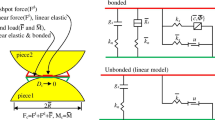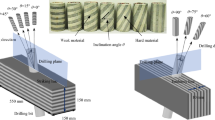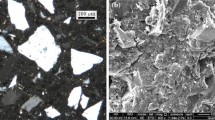Abstract
In order to study the triaxial compression creep characteristics of rock samples containing cracks, indoor triaxial compression creep tests of intact rock-like specimens and rock-like specimens with cracks were carried out. Accordingly, the effects of confining pressure, axial stress level, and the inclined angle of prefabricated cracks on the axial creep strain, axial strain rate, long-term strength, and fracture morphology of the specimens were analyzed. Based on the soft element proposed by others according to the fractional derivative theory, the nonlinear rheological model of rock-like specimens with a crack was obtained by combining it with the existing element models. The PFC2D program was developed again, and a new nonlinear rheological model was put into the PFC2D program. The PFC2D program was used to perform the numerical tests of triaxial compression creep characteristics of intact rock-like samples and rock-like samples with cracks. Based on the laboratory test, the effects of crack length on the axial instantaneous strain, axial creep strain, axial strain rate, long-term strength, and fracture morphology of specimens were further analyzed. The results showed that when the applied axial stress was the same, the average axial strain rate of the specimen first increased and then decreased with the dip angle β of the crack. In addition, the long-term strength of the sample increased with the increase of the dip angle β of the crack. The new nonlinear viscoelastic plastic creep model was used to fit and analyze the uniaxial creep test curves of intact specimens. The theoretical results agreed with the test results, showing that the model was reasonable. When the crack length and axial stress level were the same, with the confining stress increase, the axial instantaneous strain and creep strain decreased, and the long-term strength increased. When the confining stress and axial stress levels were the same, with the crack length increase, the axial instantaneous strain and creep strain would increase, and the long-term strength would decrease. The main research achievement of this study is to obtain the variation of triaxial compression creep characteristics of rocks containing cracks with influencing factors. This research predominantly furnishes theoretical backing for the design of support systems for deep underground tunnels being constructed in western China.

























Similar content being viewed by others
References
Chen BR, Zhao XJ, Feng XT, Zhao HB, Wang SY (2014) Time-dependent damage constitutive model for the marble in the Jinping II hydropower station in China. Bull Eng Geol Environ 73:499–515
Dubey RK, Gairola VK (2008) Influence of structural anisotropy on creep of rocksalt from Simla Himalaya, India: an experimental approach. J Struct Geol 30:710–718
Enrico P, Alberto T (2005) A visco-damage model for brittle materials under monotonic and sustained stress. Int J Numer Anal Meth Geomech 29:287–310
Fabre G, Pellet F (2006) Creep and time-dependent damage in argillaceous rocks. Int J Rock Mech Min Sci 43:950–960
Fujii Y, Kiyama T, Ishijima Y, Kodama J (1999) Circumferential strain behavior during creep tests of brittle rocks. Int J Rock Mech Min Sci 36:323–337
Gasc-Barbier M, Chanchole S, Berest P (2004) Creep behavior of Bure clayey rock. Appl Clay Sci 26:449–458
Hoxha D, Homand F, Auvray C (2006) Deformation of natural gypsum rock mechanisms and question. Eng Geol 86:1–17
Hu T, Yang SQ, Xu P (2018) A nonlinear rheological damage model of hard rock. J Cent South Univ 25:1665–1677
Mansouri H, Ajalloeian R (2018) Mechanical behavior of salt rock under uniaxial compression and creep tests. Int J Rock Mech Min Sci 110:19–27
Sterpi D, Gioda G (2009) Visco-plastic behaviour around advancing tunnels in squeezing rock. Mech Rock Eng 42:319–339
Tang H, Wang DP, Huang RQ, Pei XJ, Chen WL (2018) A new rock creep model based on variable-order fractional derivatives and continuum damage mechanics. Bull Eng Geol Environ 77:375–383
Wang R, Zhuo Z, Zhou HW, Liu JF (2017) A fractal derivative constitutive model for three stages in granite creep. Results Phys 7:2632–2638
Wu F, Liu JF, Wang J (2015) An improved Maxwell creep model for rock based on variable-order fractional derivatives. Environ Earth Sci 73:6965–6971
Xu WY, Yang SQ, Xie SY, Shao JF, Wang YF (2005) Investigation on triaxial rheological mechanical properties of greenschist specimen (II): model analysis. Rock Soil Mech 26(5):693–698 [In Chinese]
Yin DS, Ren JJ, He CL, Chen W (2007) A new rheological model element for geomaterials. Chin J Rock Mech Eng 26(9):1899–1903 [In Chinese]
Zhao K, Xiong LX, Kuang ZL, Xu ZY, Zeng P (2021) Uniaxial compression creep characteristics and acoustic emission characteristics of two different kinds of red sandstone with different particle sizes. Arab J Sci Eng 46:11195–11206
Zhou HW, Wang CP, Mishnaevsky L Jr, Duan ZQ, Ding JY (2013) A fractional derivative approach to full creep regions in salt rock. Mech Time-Depend Mater 17:413–425
Funding
This work was supported by the Open Research Fund of Hunan Provincial Key Laboratory of Hydropower Development Key Technology (Grant No. PKLHD202002), the Open Research Fund of State Key Laboratory of Geohazard Prevention and Geoenvironment Protection (Grant no. SKLGP2021K020), and the Open Research Fund of Engineering Research Center of Underground Mine Construction, Ministry of Education (Grant No. JYBGCZX2020101).
Author information
Authors and Affiliations
Corresponding author
Ethics declarations
Conflict of interest
The authors declare no competing interest.
Additional information
Responsible Editor: Zeynal Abiddin Erguler
Rights and permissions
Springer Nature or its licensor (e.g. a society or other partner) holds exclusive rights to this article under a publishing agreement with the author(s) or other rightsholder(s); author self-archiving of the accepted manuscript version of this article is solely governed by the terms of such publishing agreement and applicable law.
About this article
Cite this article
Xiong, L., Chen, H., Yuan, H. et al. Triaxial creep test and PFC numerical simulation of rock-like materials with cracks. Arab J Geosci 16, 613 (2023). https://doi.org/10.1007/s12517-023-11717-2
Received:
Accepted:
Published:
DOI: https://doi.org/10.1007/s12517-023-11717-2




